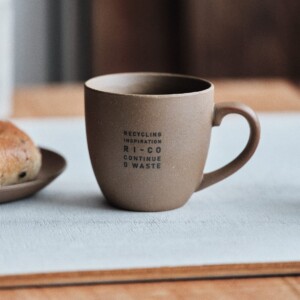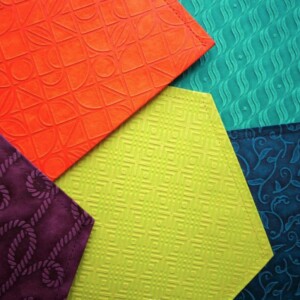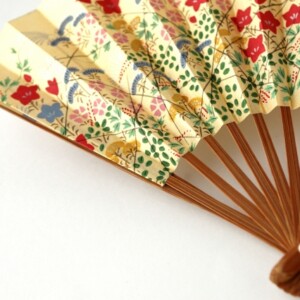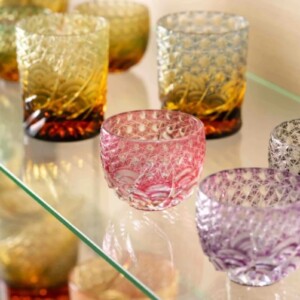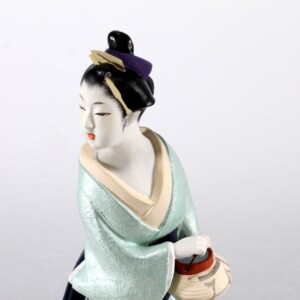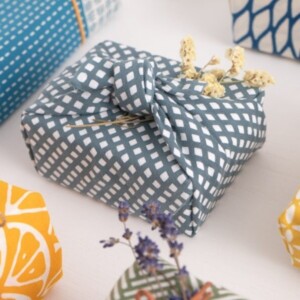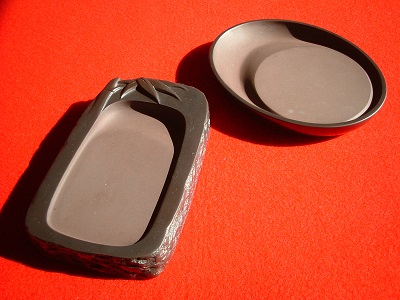
Explore the characteristics and history of Akama inkstones! What is the calligraphy tool with eternal charm?
The Akama inkstone is one of the most important tools in the world of calligraphy, with a long history.
The appeal of Akama inkstones, which have been loved throughout the ages, is not only due to their usability, but also deeply related to their cultural value.
In this article, the appeal of the Akama inkstone will be explained in detail from the perspective of its characteristics and history.
What is the Akama Inkstone?
Akama inkstones are made from Akama stone, which is found in the Shimonoseki and Ube City areas of Yamaguchi Prefecture.Dense and rich in quartz and iron, it is capable of fine sumizuri (ink rubbing) and produces inkstones with good color.
It has been known since the Kamakura period (1185-1333), and during the Edo period (1603-1867), it was mined exclusively in the mountains designated as Gochozan by the Mori clan.The highly artistic value of these inkstones, made by skilled craftsmen, is highly prized as a traditional Japanese craft that combines practicality and beauty.
History of Akama Inkstone
The production of Akama inkstones began in the Kamakura period (1185-1333) and is said to have originated from an inkstone dedicated to Tsurugaoka Hachiman Shrine by Minamoto no Yoritomo.During the Edo period (1603-1867), it was under the control of the Choshu domain and was highly prized as a gift to the feudal lord.
In 1976, the inkstone was designated as a traditional craft, and its manufacturing process has been handed down to the present day.It was a favorite of the samurai of the end of the Edo period, and is still produced in Ube City and Shimonoseki City today.
How Akama inkstone is made
The process of making Akama inkstones consists of traditional techniques handed down by skilled craftsmen.
Let us take a closer look at the process of making an inkstone into a finished product.
1. the shaft
Mining of Akama stone is done through a tunnel created by digging through the mountain. The stone is sensitive to dryness.For this reason, the tunnels are usually kept under water. Before quarrying, a pump is used to drain the water out of the tunnel before entering the pit.
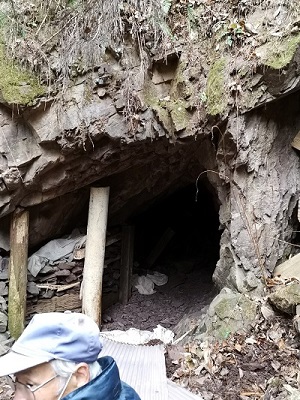
Quarrying and Sorting
Akama Stone is mined from stony formations found at depths of 5m to 40m, along tunnels that are just deep enough for a person to bend down to pass through. The rough stones are dug out using gunpowder and pick hammers, and then lightly struck with hammers to determine their suitability as inkstone by sound.
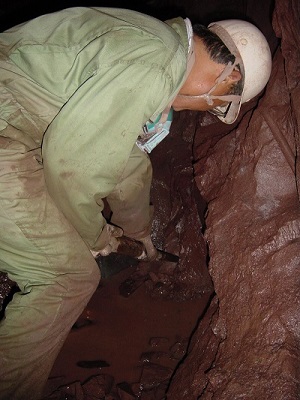
3. forming
Depending on the shape required to produce the inkstone, a diamond cutter or small tagane hammer is used to roughly shape the stone.
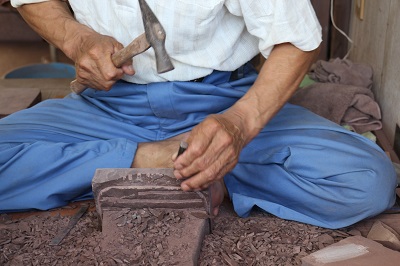
4. cutting
Using only a large piece of wood, the surface and back of the stone are roughly shaped so that they are the same thickness. Then, using water and silica sand as an abrasive, finish the stone to a uniform flat surface using a polishing board.
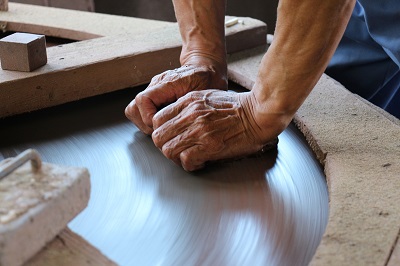
5. edge preparation
The “fuchitate” process involves determining the shape of the inkstone and cutting an incision approximately 3mm deep into the inside of the inkstone. This procedure forms the flat hill for the inkstone and the sea area where the ink will collect. After the Akama stone is processed into a board, it is shaped into the appropriate form and edges are erected at the borders to enhance the functionality of the product when in use.
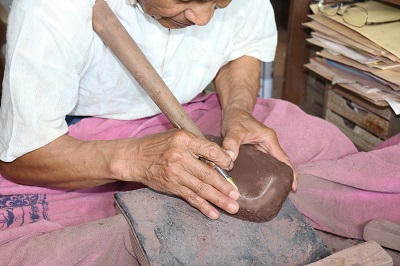
6. rough and finish carving
In the “rough and finish carving” stage, the inkstone’s hills and seas are roughly carved with a large chisel and a small pick using a compressor, and then further detailed with a more precise finish carving. At this stage, both large and small chisels are used to precisely carve the inner shape of the inkstone, forming the border called the dovetail. Finally, the inkstone is finished off with the Kiyoshi process to achieve a smooth finish and to remove any carved marks.
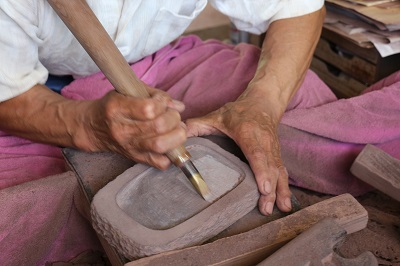
7. Rough Polishing and Finishing Polishing
The entire inkstone is polished with a whetstone or waterproof paper, and then the land area is further polished finely with a stone to allow the ink to rub off well. The chisel marks and other details are then polished with sandpaper, and finally polished again with a polishing stone to make the inkstone smooth and even. Finally, lacquer is applied to protect the inkstone and spread evenly over the inkstone with a cloth.
8. finishing (lacquering)
The outside of the inkstone, excluding the land and sea areas, is coated with a thin layer of lacquer or cashew (substitute lacquer) with a cloth and immediately wiped off. This process prevents weathering and adds luster to the surface. This process must be repeated two or three times. Finally, a finishing powder is applied and brushed to complete the process.
Features and Key Points of Akama Inkstone
Akama inkstones are made from red shale with a reddish hue, and are characterized by beautiful patterns and a variety of colored stone eyes.This stone is ideal for making inkstones, and its hardness and tenacity make it easy for craftsmen to work with it.
Akama inkstones have a long tradition in Shimonoseki and Ube cities, and the fact that a single craftsman carries out the entire process from quarrying the stone from the mountains to making the inkstone is one of the characteristics of Akama inkstones.The fine surface shape makes it easy to grind solid inkstone and produces beautifully colored ink.The natural beauty of the inkstone and the hand-carving by the craftsman are highly valued for both their functionality and artistic value.
Proper maintenance of Akama inkstones
Proper storage and maintenance of Akama inkstones require careful attention.Keep it away from direct sunlight and heat sources, and use a paulownia box or similar container to maintain proper humidity.
It is important to wash the inkstone after each use. Occasionally, polish the inkstone with water paper No. 180 while soaking the inkstone’s surface (the hill) in water, and then clean the inkstone to improve the ink’s lees.
The use of a natural inkstone is even more effective, especially for causing the sharp edges of the inkstone (like thorns in the stone).This will ensure that the beauty and functionality of the Akama inkstone is preserved over the long term.
Akama Inkstone Experience & Exhibition Facilities
Mangura Fureai Center
| Item | Contents |
| Address | 1672 Nishimangura, Ube City, Yamaguchi 757-0214, Japan |
| Telephone number | 0836-67-0201 |
| Business hours | 9:00-22:00 |
| Closed | Year-end and New Year holidays |
| Access | ・15 min. drive from Ube Station on JR Ube Line ・15 min. drive from Asa Station on JR Sanyo Shinkansen ・15 min. drive from Onoda IC on Sanyo Expressway |
| Admission fee | Free of charge |
| Experience | Yes |
Reference source: Mangura Fureai Center|Sightseeing Spots|[Official] Yamaguchi Prefecture Tourism/Travel Site Welcome to Yamaguchi
Akama Inkstone Village
| Item | Contents |
| Address | 793 Iwataki, Nishimankura, Ube City |
| Telephone number | 0836-67-0641 |
| Hours of operation | 9:00-17:00 *Advance reservations are required for tours. |
| Closed | Year-end and New Year holidays, other irregular holidays |
| Access from Ube I.C. | 40 min. by car from Ube I.C. |
| Admission fee | Free of charge |
| Experience | No experience |
Reference : Akama Inkstone Village|To See and Do|Ube Tourism & Convention Association official website “Ube Tabinavi
Summary
Akama inkstones are Japanese calligraphy tools made from Akama stone from Yamaguchi Prefecture, using a traditional technique that has been used for hundreds of years.It is characterized by its fine stone quality and unique reddish color, and can be used to finely sharpen ink, resulting in ink with good coloration.
Historically, it has been loved by many writers and ink masters since the Edo period (1603-1867), and the technique is still passed down and protected by many craftsmen today.Today, products incorporating new designs and functions while preserving traditional values can also be seen.
We invite you to visit the production site to experience the eternal charm of Akama inkstones.



